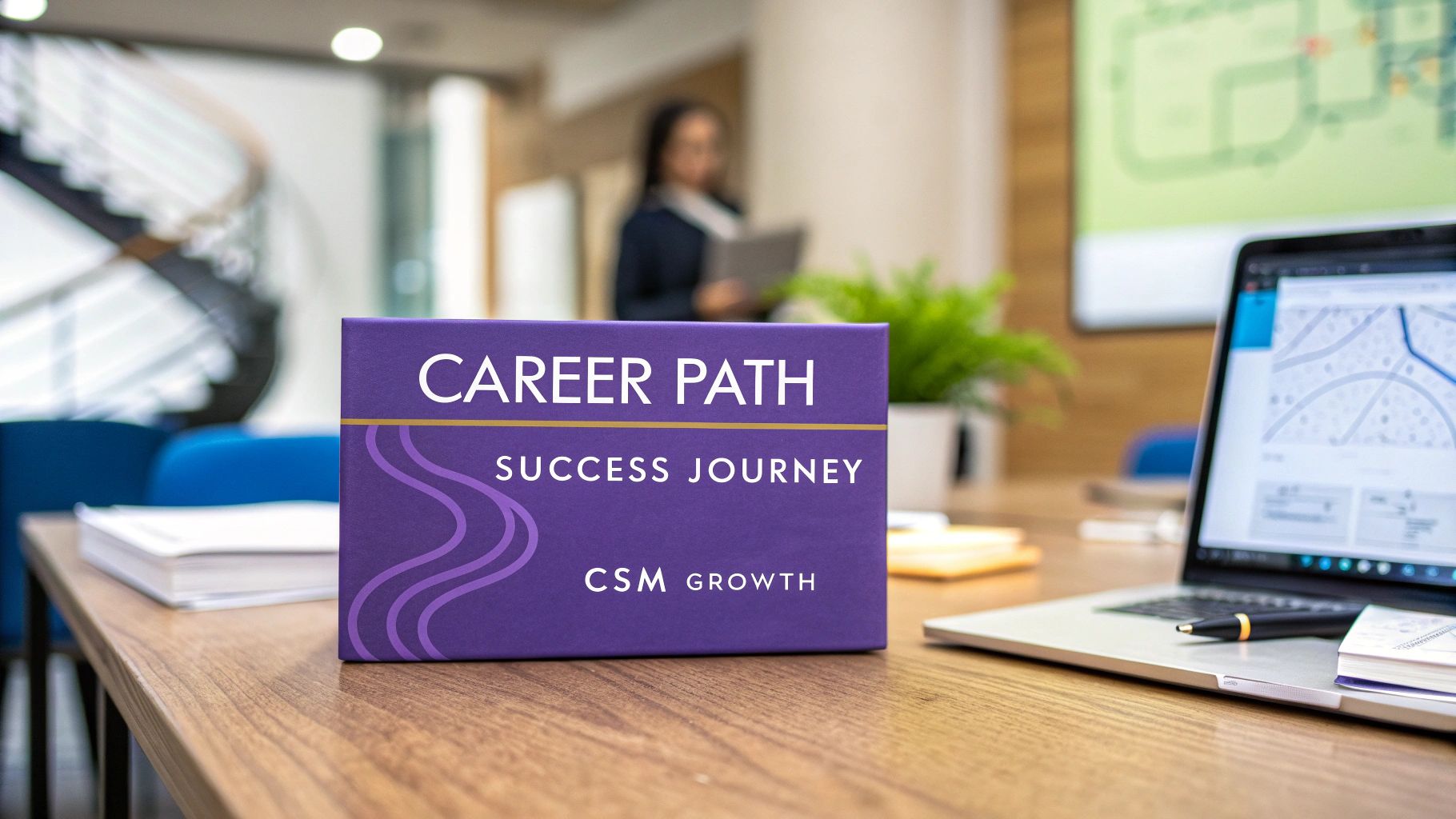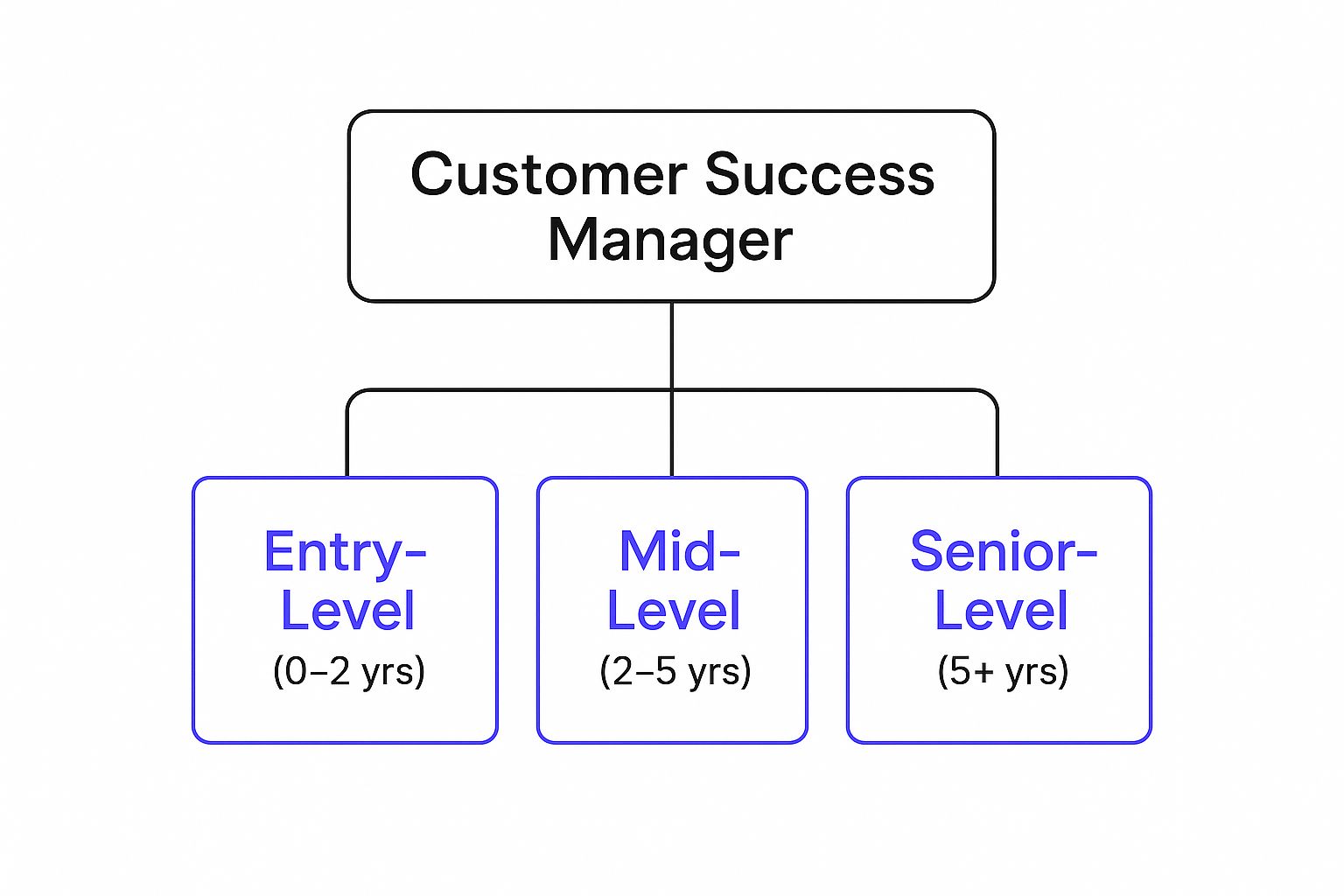
The path of a Customer Success Manager isn't a straight line from support agent to account manager. It's an evolution—a journey from reactive problem-solving to becoming a proactive, strategic partner who drives real value for both your clients and your company.
Forget thinking of a Customer Success Manager (CSM) as just another support role. A great CSM is more like a strategic guide, a trusted advisor who helps clients navigate their entire journey with your product. Your mission, should you choose to accept it, is to make absolutely sure customers get the results they came for.
When you do this well, it directly fuels customer retention, slashes churn rates, and—most importantly—uncovers new growth opportunities for your business. It's a unique blend of being a consultant, a customer advocate, and a master relationship builder.
The thread that ties the entire customer success manager career path together is a relentless focus on customer experience optimization. This commitment to creating genuine value at every single touchpoint is what truly separates customer success from old-school account management.
Customer success isn't just a buzzword; it's a fast-growing profession, especially in the SaaS and tech worlds. For anyone looking to build a career, this explosive growth is a huge green light. The global market is expected to expand at a compound annual rate of about 25.02% between 2021 and 2026. That means one thing: skilled CSMs are in very high demand.
It’s one thing to talk about a career path, but it's another to actually see it laid out. This roadmap gives you a clear visual of the typical stages and timelines you can expect as you grow in the field.

As the infographic shows, the journey is a clear progression. You start with hands-on, foundational work and gradually move toward high-level strategic leadership, often over a period of five or more years.
To give you a clearer picture of this journey, the table below breaks down what each stage typically involves. It’s a handy reference for understanding the shift in focus as you climb the ladder.
This table neatly summarizes the evolution from a role focused on individual customer interactions to one centered on broad, strategic business impact.
As you move along the customer success manager career path, your responsibilities and the skills you need will deepen and change. Here’s a quick look at what that feels like on the ground:
The core of this career is the shift from helping a single customer succeed with one feature to helping your entire portfolio of customers succeed with your business. It's a powerful move from tactical support to strategic influence.
With this foundational understanding of the roles and the progression, we can now dig into what it truly takes to thrive at each level.

Everyone starts somewhere, and in customer success, that first stop is often the Associate CSM role. Think of this as your apprenticeship. It's where you build the foundation for your entire career by getting hands-on with new customers and learning the absolute fundamentals of the job.
This entry-level position is all about learning by doing. Your main job is to make sure a customer's first experience with your product is a great one. You’ll spend most of your time guiding them through the critical onboarding process, helping them get set up and find that first "aha!" moment that makes the product click.
You are, quite literally, the face of the company during a client's most critical period. A smooth, positive onboarding led by an attentive Associate CSM can be the difference between a lifelong advocate and a customer who churns out in the first 90 days.
As an Associate CSM, your days are busy, interactive, and focused on people. You'll likely manage a portfolio of new or smaller accounts, where the goal isn't deep strategy but solid, hands-on support.
Here’s a taste of what your week might look like:
This is the front line of customer engagement. Your work ensures that new customers feel supported and confident in their decision, which is absolutely vital for preventing early-stage churn.
To really thrive as an Associate CSM, you need a specific mix of people skills. You can always learn the technical side of a product, but these core abilities are what will make you stand out and set you up for future growth.
The real power of a great CSM comes from their soft skills. The customer needs to trust your product and industry knowledge, trust that you understand their use case, and trust that your recommendations really are in their best interest.
At this stage, three skills are absolutely essential:
Mastering these skills as an Associate CSM doesn't just make you good at your job today; it builds the bedrock for the more complex, strategic challenges you'll tackle as you climb the career ladder.

Making the jump from a Customer Success Manager to a Senior CSM is a huge milestone. It’s the point where you truly graduate from being a product guide to becoming a strategic business partner. Your focus shifts away from day-to-day problem-solving and zooms in on proactive, long-term account strategy.
The Senior CSM role is less about answering "how do I use this feature?" and more about tackling the big "what's next?" for your customers. You're handed the keys to the company's most valuable accounts, and your mission is to make sure they’re not just using the product, but actually hitting measurable business goals with it. This is a pivotal moment in any customer success manager's career path.
You'll find yourself leading high-stakes quarterly business reviews (QBRs) with key stakeholders, moving way beyond simple usage stats to prove undeniable ROI. You're no longer just talking about features; you're talking about how your solution directly impacts their bottom line.
As a Senior CSM, your calendar looks completely different. Instead of being dictated by a queue of support tickets, it's driven by deep-dive data analysis and strategic planning sessions. You are expected to truly own the entire lifecycle of your most important customers.
This means you’re not just reacting to fires—you’re the one spotting the smoke and preventing the blaze before it even starts. You become a powerful advocate for your clients inside your own company, working hand-in-glove with product and sales teams to champion their needs and influence the roadmap.
At its core, the Senior CSM's job is to elevate a customer relationship from a simple service contract into a genuine strategic partnership. You become an indispensable part of their team, deeply invested in their goals and wins.
Your performance isn't just measured by customer satisfaction scores anymore. It’s all about your ability to retain and, crucially, grow your accounts. This demands a whole new playbook of advanced skills.
Leveling up to this role means adding some serious business and analytical muscle to your existing skills. Empathy and problem-solving are still your bread and butter, but now you need to pair them with razor-sharp commercial instincts.
This focus on growth is absolutely central to the role now. A recent industry report found that 83.6% of Customer Success leaders expect their teams to drive more expansion revenue next year. That puts Senior CSMs right at the heart of this strategic push. You can dig into the data yourself in the 2025 Customer Success Confidence Index findings.
Let’s make this real. Imagine a Senior CSM notices that a top-tier client's product adoption has gone flat. An Associate CSM might just fire off a "checking in" email. A Senior CSM, on the other hand, goes into detective mode.
This kind of proactive intervention doesn't just prevent potential churn. It demonstrates incredible value, solidifies the partnership, and sets the stage for a smooth, and likely bigger, renewal. This strategic thinking is what defines the Senior CSM and paves the way for future leadership roles.

After you've really hit your stride as a Senior CSM and proven you can think strategically, the natural next step is leadership. This is a massive shift. Your focus pivots from managing your own book of business to developing the people around you. It’s a transition that usually begins with a role as a Team Lead or a full-blown Manager.
These titles might sound interchangeable, but they represent very different rungs on the leadership ladder. Getting the distinction is crucial for mapping out your next move.
Think of the Team Lead role as the perfect bridge from being an individual contributor to a full-time people manager. I always call this the "player-coach" position. You're still on the field, handling a small number of your own high-value accounts, but you're also taking on your first real leadership duties.
A huge part of being a Team Lead is mentoring junior CSMs. You quickly become the person they turn to for thorny customer issues, tricky escalations, and sound strategic advice. You’re right there in the trenches with them, guiding them through complex client situations while still modeling what exceptional account management looks like.
This role lets you dip your toes into leadership without completely giving up the hands-on work you've become so good at. It's the ideal way to build up your coaching skills and show you're ready for more responsibility.
A Team Lead's success is a hybrid metric: the health of their own accounts and the growth of the CSMs they’re mentoring. It's about elevating both customer outcomes and team capabilities.
Stepping up to a Manager of Customer Success role marks a complete transition. At this point, you're hanging up your "player" jersey to become the full-time coach. Your primary job is no longer a portfolio of customers; it’s the success and well-being of your entire team.
The day-to-day is fundamentally different. You'll spend far less time on customer calls and much more time on activities that build, scale, and empower your team to do their absolute best work.
A manager's world expands to include a whole new set of responsibilities:
This is where your impact multiplies. Your success is now seen through the achievements of your team.
You can't just be a great CSM and expect to be handed a management role. Preparing for this leap requires being deliberate and proactive. You have to start demonstrating leadership potential long before a position even opens up.
Actionable Steps to Prepare:
Making the move from a top individual performer to a truly effective leader is one of the most challenging—and rewarding—steps you can take. It all comes down to a conscious mindset shift, moving from focusing on your own achievements to enabling the success of others.
Reaching the Director or Vice President level is the final ascent in the customer success manager career path. This is where you graduate from leading a team to leading the entire CS organization. You become a key player in the company's executive leadership, serving as the ultimate voice of the customer in the C-suite.
At this altitude, your perspective shifts dramatically. You own the entire post-sale customer journey, from onboarding to renewal and beyond. Your focus moves away from individual accounts and team quotas to the health, retention, and growth of the company's entire customer portfolio. This is a role built on high-level strategy, financial accountability, and organizational leadership.
As a Director or VP of Customer Success, your job isn't just to run the machine—it's to build it. You are the architect designing a scalable, efficient, and effective customer success organization that can not only keep up with but also fuel the company's growth.
You’ll find yourself spending less time in direct customer meetings and more time creating the environment where exceptional customer experiences can happen at scale. This means getting your hands dirty with:
At the executive level, your success boils down to one critical thing: proving how the CS department directly contributes to the company's bottom line. Your mission is to draw a clear, undeniable line from every CS initiative to hard financial outcomes like Net Revenue Retention (NRR) and Customer Lifetime Value (CLV).
When you're a VP or Director, your decisions ripple across the entire company. You have to think like a business leader first and a customer advocate second—true success lies in seamlessly blending both roles. You must ensure the customer’s perspective is a key ingredient in every major business decision.
A huge part of your job is building the infrastructure that allows your team to thrive. This includes:
The financial side of the career path also comes into sharp focus. A CSM worries about their portfolio's value; a VP has to think about the entire department's salary structure and its place in the market.
For example, knowing that the median salary for CSMs in the U.S. is around $88,500—a full 18% higher than the global median—is crucial. Leaders use benchmarks like these to design competitive compensation packages that attract and keep the best people. You can find a deeper dive into these salary trends from Customer Success Collective.
To illustrate how compensation grows with experience, here's a look at typical salary benchmarks in the United States.
This table showcases the typical salary progression for Customer Success Managers in the United States, reflecting how compensation increases with experience and responsibility.
As you can see, the financial rewards grow substantially as you take on more strategic responsibility, from an entry-level average of $64,912 to manager-level salaries that often exceed $88,128.
Ultimately, reaching this executive tier means you've successfully journeyed through every stage of the customer success manager career path. You've moved from hands-on support to strategic leadership. You’re no longer just managing customer relationships; you are steering a core business function that is absolutely critical to your company's long-term survival and growth.
It's completely normal to have a ton of questions when you're thinking about starting or growing a career in customer success. It's a path filled with unique challenges, but also some incredible rewards. Let's tackle some of the most common questions I hear to give you the clarity you need to map out your next move.
Think of this as your personal FAQ for breaking into the field, understanding what the job is really like, and seeing where this dynamic profession is headed.
Here's the good news: you don't necessarily need direct CSM experience to land your first role. The smartest way in is by leaning on your background in related fields—think customer support, account management, or even sales.
The trick is to reframe your resume to spotlight the skills that are the bread and butter of customer success. You need to connect the dots for the hiring manager.
Investing in yourself also goes a long way. Getting a certification from a well-regarded program like SuccessCOACHING or Cisco shows you're serious. And don't underestimate networking. Start connecting with CS pros on LinkedIn and jump into conversations—it shows you’re genuinely passionate about the space.
Let's be real—any job focused on client relationships and hitting targets has its moments. The pressure can definitely build when you're trying to save an at-risk account from churning or having tough conversations with unhappy clients. Juggling a portfolio of customers, each with different goals and personalities, takes a lot of mental horsepower.
But that stress is often balanced out by incredible satisfaction. There's nothing quite like turning a frustrated customer into a raving fan or seeing your advice directly lead to a client's major win.
The secret to handling the pressure of a CSM role is a mix of solid organizational skills, using data like health scores to prioritize your focus, and—this is the big one—working for a company with a supportive, truly customer-first culture.
When you have the right tools and a team that has your back, the challenges feel less daunting and the victories feel that much sweeter. A great tool for keeping your own development on track is a career tracker, which can help you visualize your progress.
The future of customer success is less about hand-holding and more about high-level strategy. The role is evolving far beyond just managing relationships and is becoming a central driver of business growth. As AI and automation start to handle the more repetitive tasks, it's actually a huge win for CSMs.
This frees you up to focus on what people do best: building deep, strategic partnerships. The demand is shifting toward CSMs who can clearly tie their work to financial outcomes. This means skills in data analysis and developing a strong commercial mindset are becoming non-negotiable.
The career path itself is also getting more respect in the C-suite. We're seeing more and more Chief Customer Officer (CCO) roles pop up, and that's a trend that's here to stay. The CSM of the future isn't just a voice for the customer; they are a strategic leader whose insights directly influence the entire company's direction.
Ready to supercharge your customer success strategy? Statisfy uses powerful AI to automate manual tasks and deliver the precise insights your team needs to be proactive, not reactive. Stop chasing data and start building stronger customer relationships that drive real growth. Discover how you can build a more efficient and impactful CS organization at https://www.statisfy.com.